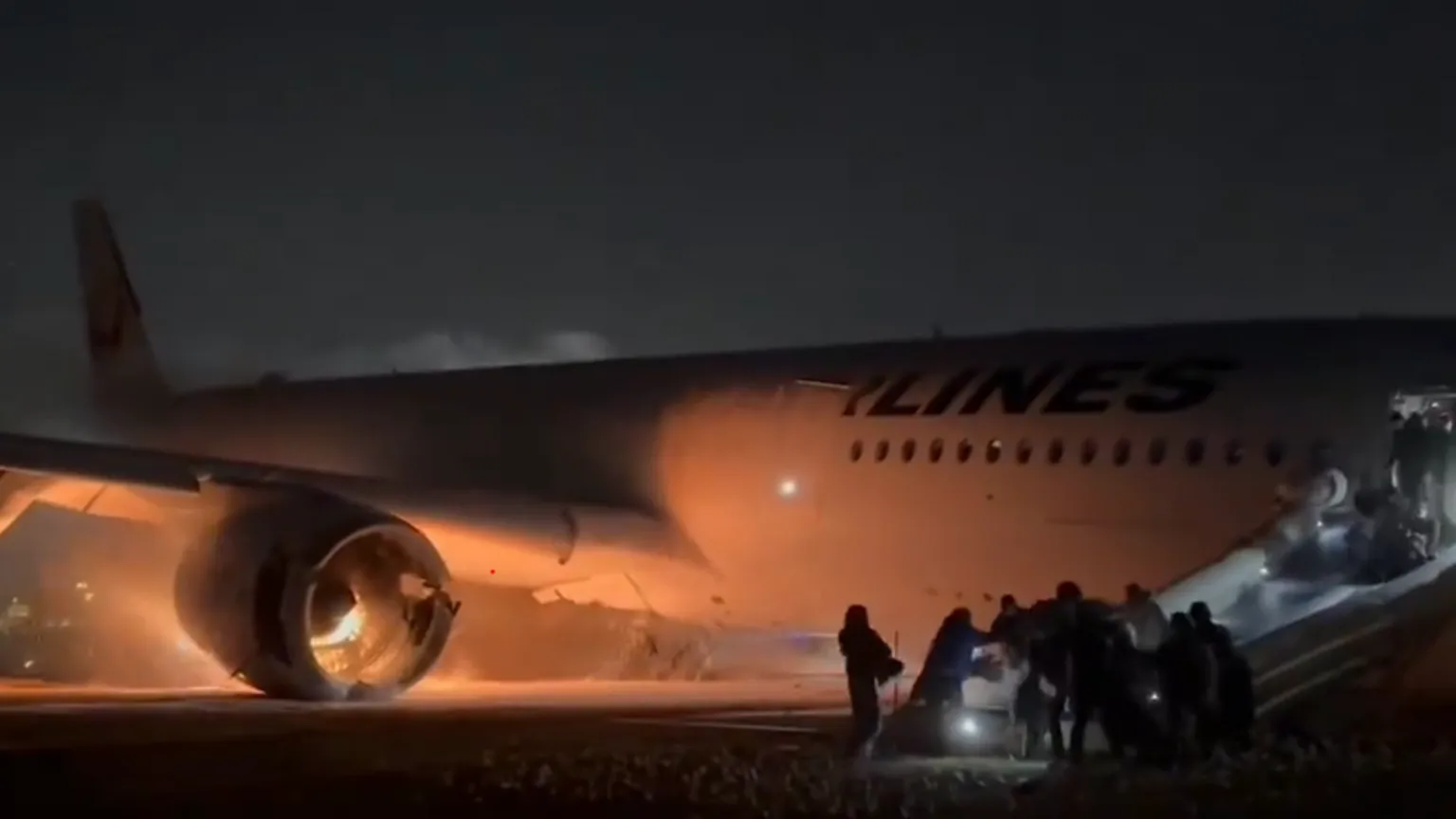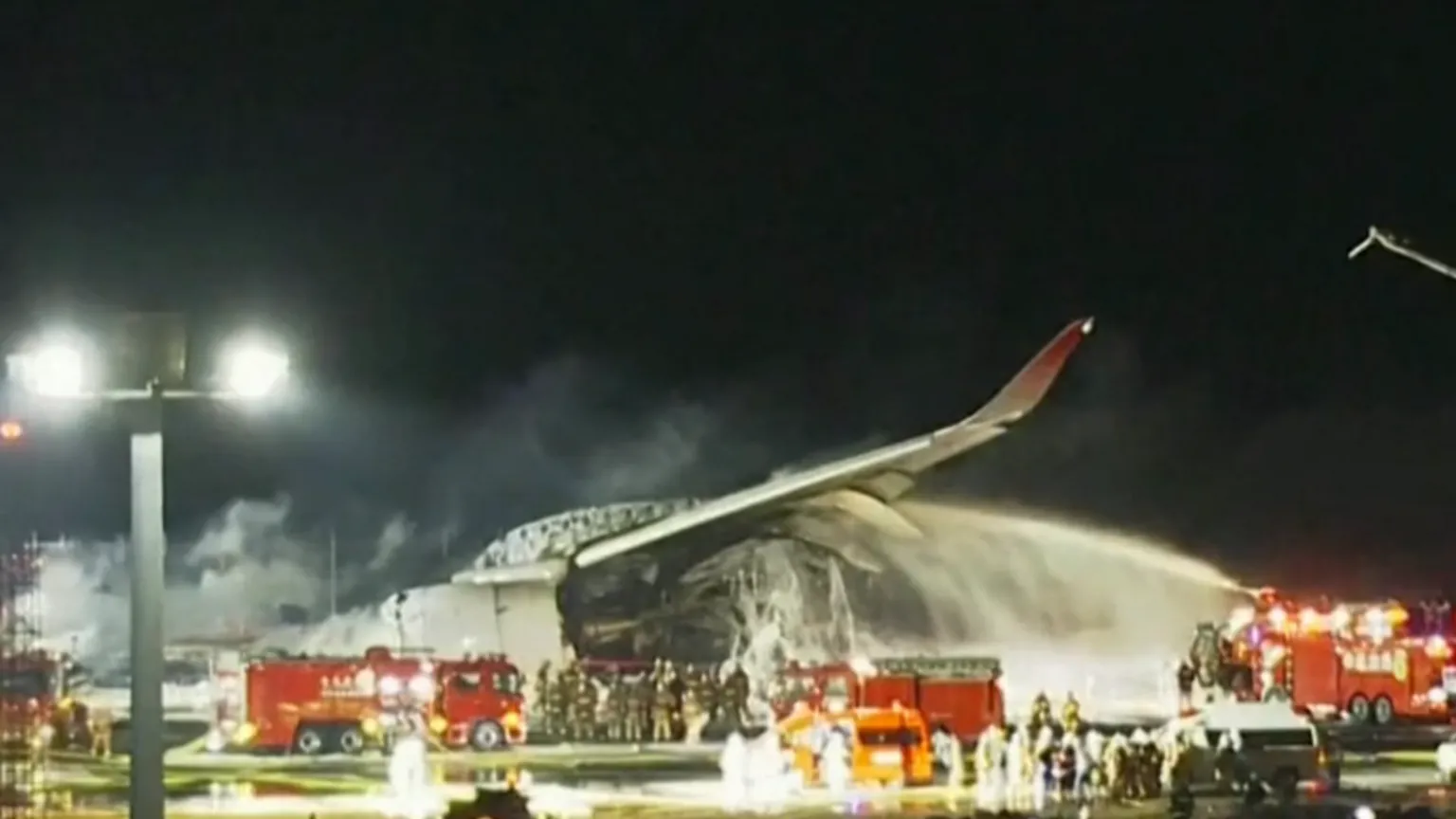Passengers on Japan’s Flight 516 Recall Chaos Inside the Plane, Japan jet crash
 As the jet engine continued to spark, those aboard the plane rushed to get away. (Image credit: BBC News)
As the jet engine continued to spark, those aboard the plane rushed to get away. (Image credit: BBC News)
The passengers aboard the Airbus A350, with a total of 379 people, experienced a sudden shock when the plane made contact with a second aircraft during descent into Tokyo.
The jet started to burn, emitting heat and smoke as it raced down the tarmac.
The primal instinct of self-preservation was activated as people rushed out of the hut, now filled with smoke, cognizant of the fact that their lives were hanging in the balance.
It is remarkable that everyone on Japan Airlines flight 516 made it out safely. According to experts, the successful evacuation and recent advances in technology both contributed to the passengers’ escape.
Behold: A plane is transformed into a fireball as it comes in to land on the runway
The passengers of the second plane, a smaller coastguard aircraft that was to provide relief to those affected by the quake, were not as lucky. Five of them perished while the pilot was severely hurt.
An extensive evacuation effort resulted in the survival of hundreds of passengers of a plane that caught fire in Japan.
Instead of using the same words and structure, this text can be rewritten as follows: It is undeniable that plagiarism is a serious issue that should be avoided at all costs. To ensure this, it is essential to modify the structure of the text while keeping the context and semantic meaning intact. This way, any form of plagiarism can be avoided.
By altering the construction of the text without altering the semantic significance or context, one can eliminate plagiarism. Keeping the markdown formatting consistent is important to ensure the integrity of the text.
Piecing together the events that occurred at 17:47 local time at Haneda airport, researchers are trying to uncover what happened and why two planes may have been occupying the runway simultaneously.
From the accounts of those who were on board, a snapshot of the event can be seen; horror and shock were experienced for a brief period of time before the reality of the situation sunk in.
Passenger Anton Deibe, aged 17 and from Sweden, recounted the disarray following the Airbus A350’s arrival at a standstill on the airstrip.
He revealed to Aftonbladet, a Swedish newspaper, that the interior of the cabin became filled with smoke in a matter of minutes.
The fumes in the room were painful to inhale. It was unbearable.
We hastily descended to the ground and then the emergency exits were opened, prompting us to rush towards them.
We had no clue of our destination, so we took off into the meadow in a rush. It was total pandemonium.
He, along with his family consisting of his parents and his sister, all managed to emerge unscathed from the ruins.
 Passengers were ready to evacuate as smoke filled the cabin. (Image credit: BBC News)
Passengers were ready to evacuate as smoke filled the cabin. (Image credit: BBC News)
According to Satoshi Yamake, a 59-year-old passenger, the aircraft had a steep tilt and then experienced a significant jolt when it initially struck something.
A different traveler reported feeling a jolt, similar to an impact, when the airship landed. A spark was visible through the window and the cabin was soon engulfed in smoke.
Kyodo News reported the testimony of one traveler who had the sensation of a “boom” and their plane suddenly being thrust upward upon landing.
Phones captured fragments of those experiences.
Passengers documented the flaming red light coming from the engine as the plane stopped. One person recorded inside the plane, with the smoke rapidly blurring the camera lens while those on board shouted and the crew attempted to advise them on their next steps.
The woman on board mentioned that it had been pitch black when the blaze became more intense after the aircraft touched down.
The temperature in the aircraft was rising, and if I’m being honest, I was sure I wouldn’t make it, she informed NHK, a Japanese media company.
A fellow passenger reported that the evacuation plan was impeded due to the fact that only one exit was available. They reported, “An announcement was issued, indicating that the rear and middle doors were inoperable. Consequently, all passengers had to disembark the aircraft using the front door.”
Viewers witness individuals quickly evacuating the aircraft via the emergency slide chute following a fire on the plane.
Footage and pictures depict the instant when individuals started to leap down the airline’s inflatable slides – some falling in their effort to escape the blazing aircraft and run to greater safety.
It doesn’t look like anyone has their large personal bags with them, which would normally be a factor in how fast a plane can be emptied.
Alex Macheras, an aviation expert, informed the BBC that the team on board “were able to commence a standard evacuation” in the immediate few minutes following the crash.
The blaze was confined to a single region of the Airbus A350 for the first 90 seconds, permitting the crew a short period of time to evacuate everyone.
He commented that the personnel were able to comprehend which entrances were far from the fire, which explains why the images illustrate that not all the exits were enabled for people to get out of.
He noted that passengers can draw out the process if they become flustered, like by attempting to collect their luggage from the storage compartments.
Composite, carbon-fiber materials make up the Airbus A350 – one of the initial commercial jets developed. This material appears to have endured the initial impact and the fire that ensued.
As the flames rapidly moved to consume the aircraft, firefighters attempted to control the fire. The video footage showed their efforts as the plane’s body started to separate into two sections.
Mr Yamake, the traveler, asserted that despite the commotion, it took everyone roughly five minutes to exit. Moreover, he noticed the blaze had spread in the span of 10 to 15 minutes.
Sawada, aged 28, expressed his amazement, exclaiming, “It’s a miracle that we didn’t die!”
After numerous hours of trying, the firefighters were finally successful in completely putting out the flames. Fourteen people who were aboard were given medical aid for their minor wounds.
As passengers tried to process what they had experienced, they informed their connections of their safety and braced themselves for the future.
Mr Sawada asked a single query. “I’m seeking an explanation for why this occurred,” he declared, indicating that he was not going to board another aircraft until a response was provided.
 Once the fire had been put out, the fuselage of the plane was left behind. (Image credit: BBC News)
Once the fire had been put out, the fuselage of the plane was left behind. (Image credit: BBC News)
The importance of avoiding plagiarism cannot be understated. It is essential to create unique content when writing and to cite any sources that one may have used. Failing to do so can lead to serious repercussions, such as a failing grade or even legal action. Therefore, it is necessary to be mindful of avoiding plagiarism when writing.
This article was initially published on BBCNews.com.
All Image Source: © Provided by BBC News




